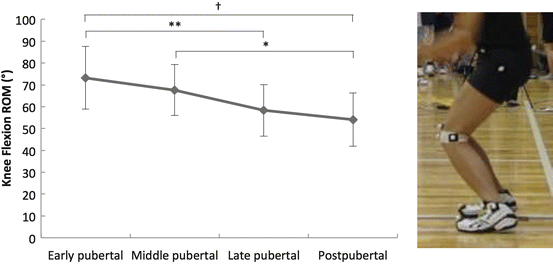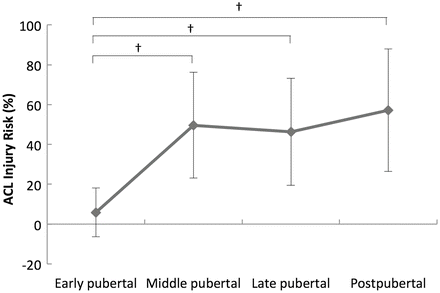Fig. 15.1
Knee valgus motion in the early, middle, late, and post pubertal stages (*:p < 0.05, **:p < 0.01, †:p < 0.001)

Fig. 15.2
Knee flexion range of motion in the early, middle, late, and post pubertal stages (*:p < 0.05, **:p < 0.01, †:p < 0.001)

Fig. 15.3
ACL injury risk in the early, middle, late, and post pubertal stages (*:p < 0.05, **:p < 0.01, †:p < 0.001)
15.3 Effect of Injury Prevention Training on Lower Extremity Kinematics
Several studies have evaluated whether implementing injury prevention program in female adolescents can alter the high-risk movement patterns. Hewett et al. (1996) first investigated the effect of a jump-training program on landing mechanics and lower extremity strength in female adolescents. Eleven female high school volleyball players and nine male control subjects participated in the study. The female athletes underwent a 2-h jump-training program for 6 weeks. Lower extremity mechanics, muscle strength, and vertical jump height were measured before and after the training period. After the training period, female athletes significantly decreased peak landing force and knee abduction and adduction moments. Hamstring-to-quadriceps muscle peak torque ratio increased on both dominant and nondominant sides. Mean vertical jump height increased after the training period. This jump-training program was thus effective in improving knee mechanics and muscle strength.
Myer et al. (2005) investigated the effect of neuromuscular training on lower extremity biomechanics in female adolescents. Forty-one female basketball, soccer, and volleyball players from high school participated in a 6-week neuromuscular training program. Age, weight, and height-matched control also participated in the study. Three-dimensional lower extremity biomechanical testing was conducted before and after the training period in both groups. The results of this study showed that neuromuscular training decreased knee valgus and varus torques compared to the control group. Therefore, this study suggested that a 6-week neuromuscular training program was effective in improving lower extremity biomechanics.
Myer et al. (2006) further evaluated the effect of plyometric and balance training on lower extremity kinematics in high school female volleyball players. Eighteen high school female athletes participated in 7-week long training sessions. Subjects were divided into a plyometric training group and a balance training group. Lower extremity kinematics were measured during a drop vertical jump and medial drop landing before and after the training sessions. On frontal plane measurements, both groups decreased the initial contact and the maximum hip adduction angle during the drop vertical jump after the training period. During the medial drop landing, both groups decreased the initial contact and the maximum knee abduction angle. In the sagittal plane, the plyometric training group demonstarated increased knee flexion at initial contact and maximum angle during the drop vertical jump. The balance training group, on the other hand, demonstrated increased maximum knee flexion angle during the medial drop landing. This study suggested that both training methods were effective in improving lower extremity kinematics in the frontal plane, whereas training effects on the sagittal plane knee kinematics were task specific.
Pollard et al. (2006) investigated the influence of in-season injury prevention training on hip and knee kinematics during a landing task. Eighteen female soccer players between the age of 14 and 17 participated in the study. Subjects underwent the Prevent Injury and Enhance Performance (PEP) injury prevention training during the soccer season. Three-dimensional kinematics were measured during a drop-landing task before and after the season. After the season, subjects demonstrated decreased hip internal rotation and increased hip abduction, although there were no differences in knee valgus or knee flexion angles. This study suggested that in-season injury prevention training was effective in improving lower extremity kinematics.
Lim et al. (2009) evaluated the effects of injury prevention training on muscle strength, flexibility, and lower extremity biomechanics in female high school basketball players. Twenty-two high school female basketball players participated in the study. Subjects were divided into training and control groups. The training group underwent an 8-week injury prevention training regime, while the controp group maintained their regular routine. Lower extremity kinematics during a rebound-jump task were measured before and after the training period. The training group demonstrated increased strength of hip abduction, hip extension, and knee flexion, as well as increased flexibility of knee flexion. The training group also showed an increased knee flexion angle and inter-knee distances, and decreased maximum knee extension torques during the rebound-jump task after the training period. This injury prevention program was effective in modifying the strength, flexibility, and biomechanical properties that are associated with ACL injuries.
Although the methods of the various injury prevention training regimes were slightly different, above studies have demonstrated that injury prevention programs are effective in improving lower extremity mechanics in both frontal and sagittal planes. The improved kinematic functions involve those which are associated with ACL injury in female adolescents.
15.4 Effect of Injury Prevention Training on Incidence of ACL Injury
A number of studies have investigated the effect of various injury prevention programs on the incidence of ACL injury in female adolescents (Hewett et al. 1999, 2000; Mandelbaum et al. 2005; Olsen et al. 2005; Pfeiffer et al. 2006; Steffen et al. 2008; Kiani et al. 2010; Lebella et al. 2011; Walden et al. 2012). Table 15.1 summarizes the results of these studies. Although some studies involve problematical methodologies, the overall conclusion is clearly that injury prevention training is effective in reducing the number of ACL injuries in female adolescents. A meta-analysis by Myer et al. (2012) investigated the influence of age on the effectiveness of injury prevention training for reducing ACL injuries. Myer et al. found that implementing injury prevention training in the mid-teen years was more effective in reducing ACL injury than such training in the late teen or early adult period. This finding suggests that injury prevention training should be encouraged in female adolescents – specifically in early adolescents.
Table 15.1
Summary of ACL injury prevention intervention studies
Author (year) | Study design | Sports | Age | No. of subjects (intervention vs. control) | Strength | Flexibility | Balance | Plyometrics | Agility | Skill | No. of ACL injury (intervention vs. control) |
|---|---|---|---|---|---|---|---|---|---|---|---|
Hewett et al. (1999) | Non-randomized cohort | Soccer, volleyball, basketball | 14–18 | 366 vs. 463 | ○ | ○ | ○ | 2 vs. 5 | |||
0.12 vs. 0.43/1,000 AE | |||||||||||
Heidt et al. (2000) | Randomized controlled | Soccer | 14–18 | 42 vs. 258 | ○ | ○ | ○ | ○ | ○ | 1 vs. 8 | |
2.4% vs. 3.0% | |||||||||||
Mandelbaum et al. (2005) | Non-randomized cohort | Soccer | 14–18 | 1,885 vs. 3,818 | ○ | ○ | ○ | ○ | 6 vs. 67 | ||
0.49 vs. 0.99/1,000 AE; RR = 0.18 | |||||||||||
Olsen et al. (2005) | Cluster randomized controlled | Handball | 15–17 | 958 vs. 879
Stay updated, free articles. Join our Telegram channel
Full access? Get Clinical Tree
 Get Clinical Tree app for offline access
Get Clinical Tree app for offline access

|





